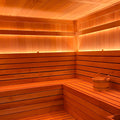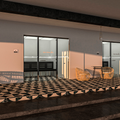Sauna vs. Steam Room, Which One Is Better For You?
If you want to invest in your health by buying a sauna or a steam room, but you can't decide which option will suit you best, you have come to the right place.
Saunas and steam rooms have always been known for providing numerous benefits and similarities, so it is very common for people to get them confused. In this blog, we will give you all the information we have available so you can learn about their benefits and differences and decide which option will suit you best.
What is a sauna?

A sauna is a wooden room or structures designed to provide heat and steam, typically used for relaxation, bathing, and promoting health benefits. Saunas originated in Finland, where they have been used for centuries as part of traditional bathing practices. Saunas are typically heated to a high temperature, usually ranging from 160 to 220 degrees Fahrenheit (70 to 105 degrees Celsius), depending on the type of sauna and personal preference the room can take anywhere from 10-40 minutes to fully heat. The heat in a sauna is typically dry, although some modern saunas may incorporate steam or humidity control features.
The heat in a sauna is usually generated by a stove or heater, often powered by electricity, gas, or wood. Rocks are commonly placed on top of the heater, and water can be poured over the rocks to create steam, increasing the humidity in the sauna if desired. Even though saunas use dry heat, temperature and humidity are adjustable by adding water to rocks, and these humidity levels can range from 5 to 10%.
Sauna sessions typically last for a set duration, with individuals gradually increasing their tolerance to the heat over time. However, it is proven that the optimal amount of time to spend in a sauna is 10-15 minutes. Saunas are know to offer various health benefits, including relaxation, stress relief, improved circulation, detoxification through sweating, and potential benefits for skin health. They are also used for socializing and leisure activities in many cultures.
What is a steam room?

Steam rooms are small, airtight, and made from materials that easily withstand high humidity and reduce the possibility of the growth of bacteria and mold. The steam generators produce hot steam by boiling water, which is used to heat the room. The temperature in steam rooms is typically around 110 degrees Fahrenheit. (43°C) Since their humidity hovers around 100 percent, it can feel much hotter than saunas, which are kept between 150°F and 195°F (65°C to 90°C).
A steam rooms are small, air tight space designed to produce steam by heating water to create a humid environment. Similar to saunas, steam rooms are used for relaxation, bathing, and promoting health benefits, but they operate on a different principle. In a steam room, a steam generator heats water to produce steam, which is then released into the room to create a high-humidity environment. The temperature in a steam room typically ranges from 110 to 120 degrees Fahrenheit (43 to 49 degrees Celsius), although it can vary depending on the specific design and preferences.
Unlike saunas, which provide dry heat, steam rooms offer moist heat due to the high humidity levels generated by the steam. This moist heat can open up pores, promote sweating, and help relieve congestion in the respiratory system.
Similar to saunas, people typically enter steam rooms unclothed or wearing minimal clothing and sit or recline inside to enjoy the steam. Steam room sessions typically last for a set duration, usually around 10 to 20 minutes, although individuals may adjust the length of their sessions based on personal preference and tolerance to the heat. Steam rooms are believed to offer similar health benefits to saunas, including relaxation, stress relief, improved circulation, detoxification through sweating, and potential benefits for respiratory health. They are commonly found in spas, fitness centers, and wellness facilities, where they are used for relaxation and rejuvenation.
The Health Benefits That Saunas and Steam Rooms Share


Saunas and steam rooms share numerous health benefits, and although they are mostly known for being excellent means of relaxation, they can also improve our health in many more ways. Here are some of the ways they can help your body:
Improved Blood Circulation
In 2018, a group of Finnish researchers released an assessment of the health advantages of sauna bathing. Several studies have linked regular sauna usage (four to seven times per week) to reduced blood pressure and a lower risk of cardiovascular illness, such as sudden cardiac death and stroke.
An excellent workout recovery tool
We enhance blood circulation and release endorphins when our bodies are exposed to intense heat, such as that offered by a sauna. Better blood flow transports more oxygen to your body, which helps replace worn-out cells. And endorphins are the body's natural painkillers; they help reduce inflammation. It's no surprise that they're known as "feel-good hormones."
Improved brain health
According to studies conducted at the University of Eastern Finland, people who used saunas or steam rooms 4-7 times a week for 15 minutes lowered their risk of developing Alzheimer's & Dementia.
Improved skin health
During your therapeutic retreat, your pores will open as you begin to sweat. This will help eliminate the accumulated dirt and dead skin cells that cling underneath your skin. The dead skin cells and dirt can cause irritation and breakouts, so it is essential to remove them.
The Pros and Cons
Now that you know what each one does and its benefits, we will discuss their pros and cons.
Sauna Pros
- Indoor sauna cost is less expensive.
- Pre-build saunas take up less space in a home.
- Saunas require very little maintenance.
- The resale value of your home will increase.
- Installation is quick and painless.
- If you are sensitive to humidity, the sauna is a better choice.
- You can choose between three different heaters: electric, gas, and wood-burning.
Click here if you'd like to learn more about the different types of heaters.
Sauna Cons
- The sauna will take up some of your home's interior space no matter where you put it.
- Risk of dehydration, make sure you are ALWAYS well hydrated before entering a sauna.
- They can be uncomfortable for those who have heat sensitivity.
Steam Room Pros
- Steam rooms eliminate the possibility of scalding.
- If you suffer from heat sensitivity, the steam room is better. The humidity makes your body feel hotter even though the temperature is more relaxed than in the sauna.
- This option works better for treating dry skin.
- The resale value of your home will increase.
- Includes a PowerZone® sterilizer that helps maintain the steam room clean.
Steam Room Cons
- Risk of dehydration, make sure you are ALWAYS well hydrated before entering a steam room.
- If not properly sanitized, steam rooms can hold bacteria.
- They can be uncomfortable for those who are sensitive to high humidity levels.
How do you effectively use a sauna?
Effective use of a sauna involves proper preparation, duration, and post-sauna practices. Allocate 10-15 minutes a day for optimal results. Hydrate well before, but avoid heavy meals to prevent lightheadedness. Consider a pre-sauna shower for skin cleansing.
Ensure the sauna is heated to 180-220°F and prepared with necessary supplies. Start with a 15-minute dry sauna session followed by a cooling shock like a cold shower. Return for a 20-minute heat and steam session, possibly with essential oils for added benefits. Finish with another cold plunge and allow complete cooling before dressing. Repeat the process for maximum benefits, but listen to your body. Hydrate well post-sauna to replenish fluids. Follow these guidelines for an effective sauna experience.
Key Points for Using a Sauna:
10-15 minute sessions daily.
Hydrate well, avoid heavy meals.
Consider a pre-sauna shower.
Heat sauna to 180-220°F.
Start with a 15-minute dry session.
Cool down with a cold shock.
Follow with a 20-minute heat and steam session.
Consider using essential oils.
Finish with another cold plunge.
Allow complete cooling before dressing.
Repeat for maximum benefits.
Hydrate well post-sauna.
How to effectively use a steam room?
To effectively use a steam room, it's important to follow certain guidelines. Start by hydrating well before entering and avoid heavy meals. Shower beforehand, especially after physical activity, to maintain hygiene in the hot and humid environment that promotes bacterial growth.
Maintain an optimal temperature between 110 to 120 degrees Fahrenheit inside the steam room to maximize health benefits while avoiding extremes that can lead to dehydration and heat-related issues.
Aim for a duration of around 15 to 20 minutes in the steam room for maximum benefits, with beginners starting with shorter sessions of 10 to 15 minutes. Avoid exceeding 30 minutes to prevent dehydration. If feeling uncomfortable or lightheaded, exit immediately, sit down, and drink water to rehydrate.
Unlike saunas, repeated sessions in a steam room may not be recommended due to dehydration risk. After completing the session, cool down by sitting and drinking water before dressing. Ensure your entire body, including your core, cools down properly before dressing.
Key Points for Using a Steam Room:
Hydrate well before entering.
Avoid heavy meals.
Shower prior to entering.
Maintain optimal temperature (110-120°F).
Limit session duration to 15-20 minutes.
Beginners start with 10-15 minutes.
Do not exceed 30 minutes.
Exit if feeling uncomfortable or lightheaded.
Avoid repeated sessions due to dehydration risk.
Cool down properly before dressing.
So, which is better? A sauna or a steam room?


Although saunas and steam rooms share many health benefits and have similar purposes, one cannot be placed above the other. Steam rooms might be appealing to those who enjoy high humidity levels, whereas saunas will be perfect for those who enjoy the dry heat sweat sessions saunas offer.
Really if you are trying to install your steam room in your home it has a higher potential to cause more water related issues if installed incorrectly and not vented or sealed. A steam room does have a number of similar benefits to the sauna but the process of receiving those benefits is vastly different.
Saunas are a more common product for home use and are normally easier to install and do not require as much technical skill. They also have the ability to be both indoors and outdoors depending on the product and preference!
In the end, it will be a matter of preference. You can go to your local gym or spa to try both and see which one will fit you best.
Last Words
We hope you find all the information we provided to be helpful and that with this information, you can finally choose which option will suit you best.
If you were looking at one of our specific products and you wanted more information on them, you can contact us by clicking the live chat button on the bottom right of this site or by calling us at + 1-888-503-8157.
